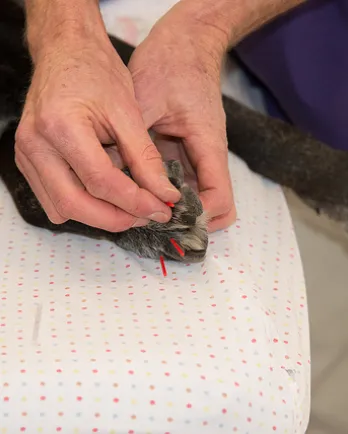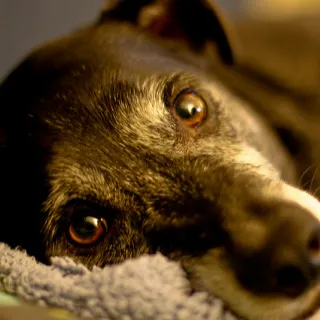Acupuncture and Traditional Chinese Veterinary Medicine by Dr. Erin Mayo, DVM, CVA
Photo credit: dagnyg via Foter.com / CC BY-NC-ND
This article is an excerpt from "Traditional Chinese Medicine" by Dr. Erin Mayo. The entire article can be read in the book Your Dog's Golden Years – Manual for Senior Dog Care, edited by Jennifer Kachnic.
What is Traditional Chinese Veterinary Medicine and how can it help a senior dog?
Traditional Chinese veterinary medicine (TCVM) is an ancient practice that has been gaining in popularity in the United States. Our geriatric pets can greatly benefit from these techniques. Even healthy dogs can see improvements in energy, attitude, physical performance and overall quality of life. TCVM does not address the animal as individual parts as Western medicine does. Instead, a TCVM practitioner will look at the pet from a holistic viewpoint and treat accordingly. In this respect, a TCVM practitioner can treat seemingly disparate conditions, such as a skin condition and vomiting, at the same time and sometimes with only one herbal formula. From the TCVM perspective, the body is seen as a whole and symptoms of disease signal an imbalance within the dog, not just the one body system.
Acupuncture is the placement of fine needles at specific locations on the body known as acupoints. These acupoints are located along a series of channels that run throughout the entire body. Channels are conduits along which vital substances, such as Blood and Qi, travel. The stimulation provided by the needles can manipulate the flow of these vital substances. Specific combinations of acupoints can relieve obstructions, draw Qi to an area of low concentration or drain it away from an area of high concentration. Acupoints can also have specific properties, such as influence over a specific body part or internal organ. Acupoint combinations, also known as point prescriptions, are tailored to the specific imbalance of each patient. It is possible that two patients with the same disease will receive very different point prescriptions because their overall imbalance of vital substances and organ function is different.
Now, if you are confused about Yin, Yang and Qi, let’s look at acupuncture from a Western scientific perspective. Acupoints are located near bundles of nerve endings and capillaries (small blood vessels). When a needle is placed in the skin, the nerves and capillaries are stimulated. Locally, chemicals are released that increase blood flow to the area. Increased blood flow can help flush toxic substances out of the area or bring important cells to the area, such as those associated with the immune system. Stimulation of the nerve endings sends chemical signals to the spinal cord and brain. This can provide pain relief or even stimulate important metabolic functions in other locations of the body. It has been documented that stimulation of acupoints on the legs increases gastric acid secretion in the stomach. Clearly, the insertion of a tiny needle in the skin can have far reaching consequences throughout the entire body.
Acupuncture does not always need to be performed with a needle. Acupressure employs touch to stimulate acupoints. Lasers use light energy to stimulate acupoints. Other techniques can be combined with needles, such as electro-acupuncture. This technique utilizes electrodes that are attached to the needles, and low levels of electrical current are run between the needles. This method is frequently employed for more severe conditions, such as paralysis. Moxabustion is a technique that involves burning dried mugwort. The compressed herb can be held near the needle or attached to the needle and provides gentle warmth, or Yang energy.
As our pets live longer, they are experiencing more troubles with degenerative joint disease, otherwise known as arthritis. Some dogs may have one painful joint, while others may feel pain in every joint. Over time, this pain may lead to disuse of the affected limb, loss of muscle mass or even loss of mobility. TCVM can be extremely helpful for this chronic and painful condition.
Acupuncture can provide pain relief without the side effects that may be associated with long-term use of anti-inflammatory medications. Needles may be placed near the painful joints, as well as other locations on the body. Again, to the TCVM practitioner, painful joints may signify many different patterns of imbalance. This pain could be from stagnation of the flow of Qi in the joints, or it could be from the collection of pathological substances that will need to be broken down and flushed out of the body. These two patterns may stem from very different underlying causes, and it is the underlying imbalance that must be addressed. If the underlying cause of the arthritis can be identified, it is possible to halt progression.
TCVM has much to offer a senior dog. This ancient medical practice uses methods that are safe, gentle, and most importantly treat the whole dog, not just the disease. Maintaining balance within the body ensures health and well-being. When this balance is lost, disease will occur. TCVM involves evaluating the entire dog, and treatment focuses on re-establishing balance so that the body can heal itself.
The information presented by The Grey Muzzle Organization is for informational purposes only. Readers are urged to consult with a licensed veterinarian for issues relating to their pet's health or well-being or prior to implementing any treatment.
The Grey Muzzle Organization improves the lives of at-risk senior dogs by providing funding and resources to animal shelters, rescue organizations, sanctuaries, and other nonprofit groups nationwide.



